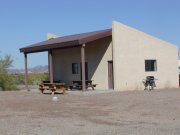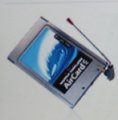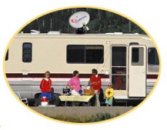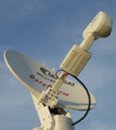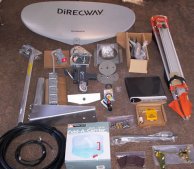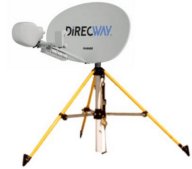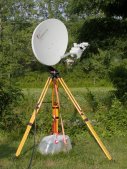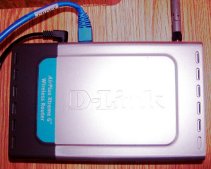RV Lifestyle
Below is a review of the RV magazines with which I am familiar. First is a general description of the content, followed by my opinion of that content. There are others, but these are the ones that I am knowledgeable of.
Escapees Magazine
 This is the magazine of the Escapees RV Club. This magazine is of general interest to RVers as well as to the membership. It does have news of particular interest to members, but it also has some of the best and most useful articles of any magazine around. Thoughts for the Road, a column by founder Kay Peterson, are always thought provoking. The magazine is just under 90 pages with very little advertising, and the articles and stories are excellent, and of general interest. It does have classified ads, new product reviews, and a subscriber opinion page. At the back is a list of all SKP parks. The most unique part of this magazine is the fact that the content is mpst;y written by members and the pay that they receive is very small. These articles are very professional, even though the writers are not writing as a profession. This is in my mind, the very best of the RV magazines. You must be a member of Escapees to get the magazine and it would be worth the price if that were the only reason that you joined.
This is the magazine of the Escapees RV Club. This magazine is of general interest to RVers as well as to the membership. It does have news of particular interest to members, but it also has some of the best and most useful articles of any magazine around. Thoughts for the Road, a column by founder Kay Peterson, are always thought provoking. The magazine is just under 90 pages with very little advertising, and the articles and stories are excellent, and of general interest. It does have classified ads, new product reviews, and a subscriber opinion page. At the back is a list of all SKP parks. The most unique part of this magazine is the fact that the content is mpst;y written by members and the pay that they receive is very small. These articles are very professional, even though the writers are not writing as a profession. This is in my mind, the very best of the RV magazines. You must be a member of Escapees to get the magazine and it would be worth the price if that were the only reason that you joined.
I subscribe.
Highways
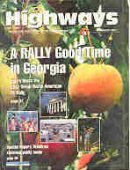 This is the magazine of the Good Sam Club. It too has things of general interest. This is a fairly good magazine. The columns Newsline, RV Insight, Action Line, and Tech Topics, are what make the magazine of interest to all RVers. There are other things, which are well written, and worth your time, but there are also some very slanted articles in support of the other services and products of the Affinity Group, which is the parent of the Good Sam club. Good Sam is actually a "for profit" business, and not a true club. I doubt that I would pay as much as the GS dues for the magazine alone. It is good, but probably not that good.
This is the magazine of the Good Sam Club. It too has things of general interest. This is a fairly good magazine. The columns Newsline, RV Insight, Action Line, and Tech Topics, are what make the magazine of interest to all RVers. There are other things, which are well written, and worth your time, but there are also some very slanted articles in support of the other services and products of the Affinity Group, which is the parent of the Good Sam club. Good Sam is actually a "for profit" business, and not a true club. I doubt that I would pay as much as the GS dues for the magazine alone. It is good, but probably not that good.
I no longer subscribe.
Motorhome
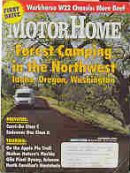 The Affinity Group publishes this magazine. It is an excellent magazine with quality publishing techniques and is very attractive. The travel articles are well written and usually accurate. Hotline, Lifestyle, and MH News, are regular features that are worth the time of any RV'er. Of interest to all owners of motor homes are Coach & Chassis, Powertrain, and Quick Tips. The reviews of motor homes are diminished by the fact that the publisher not only accepts advertising form the manufacturers, but they frequently have a full page ad for the reviewed motor home on the adjoining page to the article. I have never seen any but the mildest of criticisms in a review, but the specs and data are accurate and the review is generally accurate. This magazine should be very useful to any motorhome owner.
The Affinity Group publishes this magazine. It is an excellent magazine with quality publishing techniques and is very attractive. The travel articles are well written and usually accurate. Hotline, Lifestyle, and MH News, are regular features that are worth the time of any RV'er. Of interest to all owners of motor homes are Coach & Chassis, Powertrain, and Quick Tips. The reviews of motor homes are diminished by the fact that the publisher not only accepts advertising form the manufacturers, but they frequently have a full page ad for the reviewed motor home on the adjoining page to the article. I have never seen any but the mildest of criticisms in a review, but the specs and data are accurate and the review is generally accurate. This magazine should be very useful to any motorhome owner.
I subscribe.
Trailer Life
This is Affinity's counterpart to Motorhome for the RV'er who chooses to tow a trailer. Some articles appear in both magazines, but not all. It is of equal quality and content. When I owned a trailer I read it as faithfully as I now do Motorhome. I recommend it to those who own fifth wheels and trailers.
I no longer subscribe.
Motor Coaching
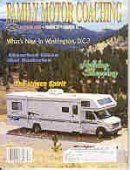 This is the magazine of the FMCA. You must own a motor home of some type to join this club. The magazine has columns Technical Inquiries and Tech & Travel Tips that are excellent. Their product reviews are also well done. The magazine is as quality a publication as I have come across in the RV world. It is also the largest of the RV magazines, running more than 200 pages. It has articles that are written by both members and professional writers. If rallies for motor homes are your thing, you will love this magazine. A large part of it is dedicated to promoting the future rallies and to telling about the past ones. There are the usual columns of interest to members and some very good travel pieces. The magazine is well written and professionally presented.
This is the magazine of the FMCA. You must own a motor home of some type to join this club. The magazine has columns Technical Inquiries and Tech & Travel Tips that are excellent. Their product reviews are also well done. The magazine is as quality a publication as I have come across in the RV world. It is also the largest of the RV magazines, running more than 200 pages. It has articles that are written by both members and professional writers. If rallies for motor homes are your thing, you will love this magazine. A large part of it is dedicated to promoting the future rallies and to telling about the past ones. There are the usual columns of interest to members and some very good travel pieces. The magazine is well written and professionally presented.
I no longer subscribe.
Trailer Life RV Directory
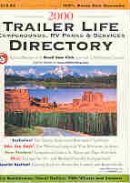 This is the directory that we have used for the past ten years or so. We use it primarily because it has the best directions to parks of any directory we are familiar with. It is a good directory, but not a great one. The ratings are frequently higher than we would give and sometimes we wonder why two parks that we find to be very different, have the same rating. It also appears to us, that any park, which advertises, cannot receive a rating that is less than 5. I do not know a lot about the manner of rating the parks, but I do know that the people who do the ratings also sell the advertising at the same time that they do the rating. As far as I have been able to determine, none of the other directories are any better. The Affinity Group publishes both this and the Woodall's directory.
This is the directory that we have used for the past ten years or so. We use it primarily because it has the best directions to parks of any directory we are familiar with. It is a good directory, but not a great one. The ratings are frequently higher than we would give and sometimes we wonder why two parks that we find to be very different, have the same rating. It also appears to us, that any park, which advertises, cannot receive a rating that is less than 5. I do not know a lot about the manner of rating the parks, but I do know that the people who do the ratings also sell the advertising at the same time that they do the rating. As far as I have been able to determine, none of the other directories are any better. The Affinity Group publishes both this and the Woodall's directory.
I purchase a new copy every other year
Workamper News
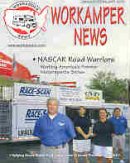 This is the magazine for the person who wishes to work while traveling or to spend time as a park volunteer for their campsite. If it isn't the best magazine of it's type, then the best one has stayed well hidden! It has columns on how to find and to keep jobs for the RV'er and how to be sure that the job is a fit. It has features about noteworthy places to work and some about people who are doing the jobs. But mostly it has ads from those who wish to have us as employees or as volunteers. The jobs are listed by state and region to help you locate something in the area where you wish to travel. There are usually about 40 pages of them and they are of every type imaginable. They also take ads from those seeking jobs. I don't know why as if you can't find something in this magazine, you must be unemployable! It comes out every other month and it has to be the greatest bargain out there.
This is the magazine for the person who wishes to work while traveling or to spend time as a park volunteer for their campsite. If it isn't the best magazine of it's type, then the best one has stayed well hidden! It has columns on how to find and to keep jobs for the RV'er and how to be sure that the job is a fit. It has features about noteworthy places to work and some about people who are doing the jobs. But mostly it has ads from those who wish to have us as employees or as volunteers. The jobs are listed by state and region to help you locate something in the area where you wish to travel. There are usually about 40 pages of them and they are of every type imaginable. They also take ads from those seeking jobs. I don't know why as if you can't find something in this magazine, you must be unemployable! It comes out every other month and it has to be the greatest bargain out there.
I subscribe.
RV Journal
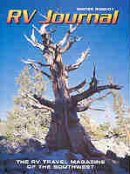 This magazine bills itself as "the RV travel magazine of the Southwest." It has well written travel features which often cover areas that are not well known, but worth the time to visit. It is a quality magazine, but it does have a high percentage of advertising. It is published quarterly and each issue has an emphasis on a featured southwestern state. Additionally each issue has some content on other states in the region. At $12.50 per year, I do not consider it to be worth the price, but they are frequently found in racks for free distribution at RV supply stores in the southwest, and I do pick one up and read it then. Remember that even a free subscription must have postage paid on it when forwarded to you.
This magazine bills itself as "the RV travel magazine of the Southwest." It has well written travel features which often cover areas that are not well known, but worth the time to visit. It is a quality magazine, but it does have a high percentage of advertising. It is published quarterly and each issue has an emphasis on a featured southwestern state. Additionally each issue has some content on other states in the region. At $12.50 per year, I do not consider it to be worth the price, but they are frequently found in racks for free distribution at RV supply stores in the southwest, and I do pick one up and read it then. Remember that even a free subscription must have postage paid on it when forwarded to you.
I do not subscribe.
Why Do This?
There are many reasons to consider spending at least some of your time as a volunteer when you become a full-time RV’er or an extended travel RV’er. If you have never considered doing this, perhaps you should! In this page I will attempt to explain a little of what we do and why we do it. This is one of those things that an RV’er can do as much, or as little as they wish and the opportunities to do so are almost endless. There are many reasons to try this as well as many benefits to be gained from the experience. As much as we love our RV lifestyle, we really do not care much for living in RV parks. As a result of this life, we spend only short periods in commercial RV parks.
Why Volunteer?
The reasons that we began spending time as volunteers along the way as we travel were mostly due to our limited income when we first went on the road as well as the fact that we believed that we would tire of constant travel in a pretty short time. But in the past three years we have discovered a whole new lifestyle that we never imagined existed. There are many benefits to our way of life and I will only be able to list a few, but this should give you some ideas. We have always been people that were involved in the communities where we lived. Going on the road has not changed that and our volunteer experiences have filled our need for involvement. As a volunteer you have a place to belong as soon as you arrive in a new location. Once introductions are completed you are once again among friends. The other people that choose to do this will usually be people who share your values and who also have the need to contribute, even after retirement. Volunteers tend to see each new community from a position much more like those who live there. We not only see an area in much more depth than does a tourist, but we also become acquainted with many residents. We leave with far more than a hand full of pictures to remember each stop, having frequently made life long friends. And there is always the financial benefit of the free place to stay
What Benefits do Volunteers Receive?
Almost everyone is aware of the volunteers who live in a campground at the local parks. The best-known benefit of the position is the campsite itself. Usually the host will have full hook-ups. In most locations there is a laundry room for the use of volunteers and frequently other things like showers, refrigerators, freezers, and just about any equipment that can be made available with minimal expense to the agency. At times there will also be a phone connection available to the site, but the bill will normally be your responsibility if you choose to have it connected. But if not, there is almost always a phone nearby that you can use if you have a phone card for long distance calls. In some locations propane is also supplied. It is quite common to receive an annual pass to all other parks that are operated by the agency you work for. Frequently, a vehicle will be supplied for use when you are working. On occasion a small stipend will be given to cover your expenses, and rarely there will also be extra work available to you for some small rate of pay. Volunteers are not targets of the IRS for their free campsite under the barter rules like paid work-campers are starting to be. There is almost always access to workshops and office equipment, should you wish to use them. Another money saving advantage to this life is the knowledge of where to shop for anything you want in order to receive the best quality and lowest prices. This can be quite significant in some locations. And you should never under-rate the value of the appreciation that is expressed along the way. There is no paid employee who's boss, no matter how great, will approach the gratitude that is typically expressed to those who work as volunteers.
Who uses Volunteer Staff Members?
There is an amazing array of locations that seek help from people willing to volunteer, and the list is growing. Almost every agency that has public parks have at least some that use volunteers as a part of the staff. We have worked for state parks, county parks, a wildlife refuge, and a department of forestry. Most public land agencies, like the BLM, Corp of Engineers, Bureau of Reclamation, US Fish & Wildlife Service, and the National Park Service use volunteers in many different positions. Nearly all states now have at least some parks with campground hosts, and many use volunteers as interpreters, tour guides and in maintenance or living history. In several states game and fish departments now use volunteers, along with many counties and some cities. There are also nonprofit organizations that seek volunteer help such as the Nature Conservancy, church camps, and a number of others. More and more tight budgets are causing organizations in the government and not-for-profit agencies to seek to fill positions with volunteer workers. And as that happens a wider range of jobs and jobs with more responsibility are opening to volunteer service.
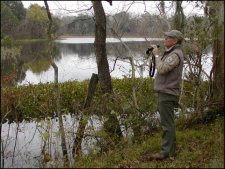
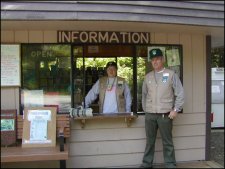

Different Work at Different Locations
The work that is done in the volunteer positions is as varied as the places that you find positions. Everyone knows about the campground host that greets campers and answers questions. While this is still the most common position for volunteer service by RVers, it is by no means the only one. There are many places that use volunteers to do lawn care and general maintenance. There are locations where volunteers feed fish, run farm machinery, plant trees, and just about every skill that you might have. We even know of two heavy equipment operators that run bulldozers for the Fish and Wildlife service. There are many organizations that seek people with office and retail skills as well as computer knowledge. I have been asked about website creation on more than one occasion. There are even places that wish only for the volunteer to live on site for reasons of security. But you should be sure that you understand what the agency is asking to insure that you can do the job and that it will not be something that you will enjoy doing. A few places do ask volunteers to do such things as cleaning, so use some degree of care. You should spell out in writing if there is a particular job that you are not willing to do, like cleaning restrooms. Most locations will be inclined to try and find things that they need done which you enjoy doing. As volunteers become more in demand, the work that they are offered is becoming more meaningful. You can usually find work with as much or as little responsibility as you wish. You should also make sure that the coordinator is aware of any health restrictions that you may have. Some examples of things that we have done that you may not have thought of are art work, bookkeeping, grant applications, teaching school children about a historic site, fence construction or removal, farm equipment operation and repair, wood restoration, carpentry, electrical wiring and repair, wildlife observation, fee collection, campsite repairs, sign posting, and a host of others. With the exception of those locations that the RV'er is just on site for security, there is always a minimum number of hours required of a "live on" volunteer. It is quite rare for that requirement to be any fewer than twenty hours total per week for the campsite. Often the required hours will be slightly higher for a couple than for a single person. Common numbers are twenty hours for a single and twenty four hours split between two, for a couple. Frequently the agency may ask for more. We have been in locations where the required hours were seldom actually asked for, but they nearly always ask you to record at least the minimum number of hours for their reports to the supervisors. Generally, the federal agencies ask for more hours of service than do the states and counties. We have worked as much as three days per week each, for our site and utilities. But we also found that with the greater time requirement went more responsibility and more challenging and enjoyable work. Interestingly, the two places that we enjoyed our work most were the two where we worked the most hours. Do not assume that when you go to another location for the same agency the time asked for will remain the same. While that is usually the case, there are exceptions so always ask. It is also quite common for people to become so involved in the organization that they find themselves working extra hours to accomplish goals, not because they were asked to, but because they want to. When you consider the hours that are asked for, keep in mind that this is a volunteer position with benefits, and not a case of barter of services for a site. There is a reason that IRS rules specifically exempt "live on" volunteers from any tax liability for the value received. If you are seeking a good return in financial value for your labor in terms of an hourly rate, you will find very few positions that are worthy of your time, but if what you seek is satisfaction and a feeling of contribution as well as interesting experiences and new things to learn, this may well be the lifestyle for you.
Finding places to Volunteer
There are many ways to find places to volunteer. Probably the best way to get started is to subscribe to the "Workamper News". If you are not familiar with this magazine, it is published bimonthly and is mostly ads from people who wish to hire RVers for seasonal help, sprinkled with ads from public and private non-profit organizations that seek RVers to volunteer their time in return for free camping. The magazine is well worth the money and it has been the primary source of locations for us in our first six years of this lifestyle. There are also many other ways to locate positions. The Internet is a good place to do a search. Look at any agency that has parks, such as the Corp of Engineers, BLM, Bureau of Reclamation, and the National Park Service. The Forest Service also uses volunteer hosts, but most of the campgrounds that they have are now being contracted to private companies and the jobs are usually paid and do much more work than we usually are interested in. The TVA and the US Fish and Wildlife Service also use volunteers. Nearly all state park systems have at least a few volunteer positions, with some states having several positions at each park. Of the states we have visited, Oregon and Texas use the most volunteers in their parks. Many cities and counties are now using volunteers in their parks and in several states the Game & Fish Department now use volunteers. We watch for volunteer host sites in parks as we travel and when we see them we always take time to ask how they got the position and how they like the work at the park. It is not difficult to locate a place to spend some time if you are serious about volunteering.
Getting the Position
Once you locate the place that you want to volunteer, the next thing to to find out if it is a good fit for you. First you must make contact. While some ads do give a mailing address, I would only use the US mail for positions that are many months away. If there is an e-mail address available, that is usually my first choice. If it is a location or position that I especially want, I will call them on the phone. Don't be afraid to call a park that has no ads or other indication that they are looking for volunteers, if it is one that you really want to spend some time in. They may not have a position, but very often they do. And I have never known anyone to have been offended by a call about volunteerism. It is just as important to let the volunteer coordinator know what you are not willing to do, as it is to find out what they want you to do. When you believe that you understand, it is good to repeat back to them what you believe to be the requirements in hours worked and in duties. While most coordinators do try and find work that the volunteers enjoy, it is only normal for them to have at least some specific plans for what they wish to accomplish. There is usually an employment application that must be filled out. If you will be driving a motor vehicle they usually want to check your driving record. Some parks also ask for your social security number in order to do a background check. This is done at many parks where you will have public contact. A short resume is helpful to the coordinator also. It should be one to two pages and it should tell what you have done that might apply in this position. If you have experience in other positions as a "live on" volunteer, list them along with a brief explanation of your duties as well as the name of your supervisor and how to contact him. While coordinators do like to have volunteers with prior experience, it is far from necessary. Everyone starts with no previous experience and most all of us come from a career of some type where we had a lot of experience.
What's left to do?
Many people always go and visit a location prior to accepting a position. While that is perhaps a good approach, for us it doesn't work because we choose locations in areas that we have never visited and so we almost never see the next site until we arrive for our stay. For us that has worked very well but we do spend some time in discussing it in detail with the staff. We also usually ask for a digital picture of the RV site, unless we have known someone who has previously been there. Once you have booked into a location, it is wise to make contact again just a few weeks before you actually travel to the location. They will want to know what day to expect you and you will need to know when the site that you are to occupy will be available to you. Some parks will have a place for you to stay if you arrive a few days early, but not all, so make sure. We usually try to arrive in the area a few days early just to be ready to start work at the time they are expecting us. When we arrive in the area, we normally unhook our toad in a local store parking lot and drive to the park to make contact with the staff and to check out where we will be staying. If we are going to be campground hosts, this is less important as they will have good access, but in some day use facilities the host sites are in unique locations. At this moment we are parked beside a conference center, with the rear of our motorhome actually in the entry to a courtyard. It happens to work very well since we are sheltered from any winter wind, and we have a nice tree and view out of the front windows. But getting parked was a bit more of a challenge than it would be in a normal campground. At this point you should be all set to spend some time in what will be a new and wonderful experience. We have learned more new things and had more new experiences since we began this life than one could ever imagine. Our only regret is that it does take quite a period of time to get around to all of the different things that there are to do. For that reason we have now begun to limit our term of stay to no more than three months and we no longer return to the same location unless it happens to be close to our grandchildren. It is a wonderful life, so have fun!
More and more, access to the internet has become important to RV owners. To some, access is as important as is telephone service and while cellular phones are rapidly making telephone service a non-issue, internet access is also much more available, but the choices are anything but simple.
To choose that method of access that will serve you best and give you good value for the money that you spend, you first need to decide how vital the internet is and just what you will use it for. It is also important to consider just how much time you will need access. It is very different for one who lives in the RV full-time when compared to someone who only uses their RV for vacations and week ends. And just how much will you use the internet and how important is it? Some people only use the internet for email to stay in contact with family, while others may operate a business that requires access several hours every day. Budget is also a factor as the cost of equipment ranges quite widely. I will try and help users to have some feel for the level of access for each method and about what it will cost for the equipment and service will be.
A device which used to be very popular, but seems to be fading away today is the Pocketmail. For $120 you can purchase the device needed for sending and receiving mail and the monthly fee is about $15. For this you get an email address, toll free phone numbers for use in the US & Canada and unlimited message service. The device works with any phone or even your cell phone and has proven to be reliable. It can also retrieve messages from another mail box or an ISP if you wish. The messages are read and composed, off line and then sent or received from the nearest telephone. The most serious drawback is that it will not receive attachments, but the message and attachment are left in your mail box so that you could pick it up by some other means..
Nearly all modern laptop computers now have a built in modem for connection to a telephone line. This will allow you to use the laptop to connect to a normal wire-line ISP (internet service provider) if you have one. Most national ISP's today have local phone numbers in all large to medium cities and nearly all commercial RV parks provide at least one line for the use of the customers for sending and receiving email. But surfing is rarely allowed on these lines. A few RV parks have lines to each site, but most of these are only available if you stay long enough to have the phone company connect you and send the bill to you. A few parks have what is called "instant" phones where you dial out just as you would at a motel, but this is not common. Telephone internet service will work while traveling as long as you realize that it is very limited and little surf time will be available. DSL service and cable internet service are not available in any RV parks that we have been to. Remember too that phone lines will be very slow by today's standards.
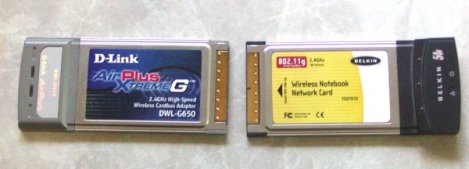
One of the most rapidly growing methods of internet access is what is called WiFi. WiFi is slang for wireless fidelity, which really doesn't explain much. What really happens is that your laptop uses a small radio receiver that is either built into the computer, or that plugs into a slot in the side of the computer, to receive radio transmission of an internet access signal. To use one of these cards, there must be what is called a "hot spot" near by or you must be near some other internet user who has a wireless router that is not using security. Hot spots are provided by some RV parks, many truck stops, some state's roadside rest areas, a few state parks, all Kinko stores, and many other outlets. While hot spots are being added to RV parks at a very rapid rate, as yet they are available at no more than 25% of the RV parks that we have been in. The other problem of using wifi is the fact that so far, many RV parks do charge extra for it's use. I have seen rates that range from $3 per night to as much as $10 per night in a KOA. Most of the companies that supply the hot spots do sell an annual subscription, but you then must find an RV park served by that subscription service and there are many different companies providing the service to the RV parks. Flying J and some other truck stops also sell an annual subscription. You can also use this service at cyber cafes and many other locations and there will be times that some router will be in range that has no security and can be used free. There are also some RV'ers with dish service that will allow another RV'er to use their service if you ask One of the drawbacks to using this type of service is that many RV parks have areas of poor reception.
The next possible way to access the internet is the use of an "air card" from either Verizon or Cingular cellular service companies. These cards plug into the laptop just exactly the way that a WiFi card, or any other pc card does. To use this service you must be in range of cell phone service and not all areas with phone coverage as yet have this available. But it is by far the best way to have internet from a cell service company. There are cables and cards that allow you to use your cell phone for internet, but if you use it for more than receiving email, most find the phone connection to be too slow. The air card approaches the speed of a broad-band connection and is probably one of the best methods currently available. The cost ranges from as low as $20 per month to as much as $60 per month for 5 gigabytes access time. The 5 gig limit is pretty much the same as unlimited for most unless you like to down-load moves or numerous songs. It gives about 200 songs or2 to 3 movies, per month. You do not want to exceed that 5 gig as it costs $0.25 per megabyte from that point on. 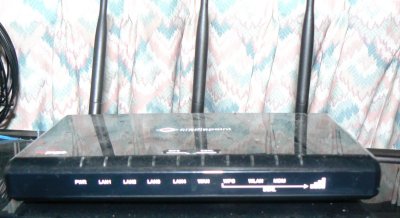
In June of 2009 we discontinued use of our Starband dish service and changed to the Verizon Data Service. So far we do like it, although it is somewhat less available than was our dish service. The big benefit is the lack of equipment needed and the fact that it can be used simply by turning on your computer. We have also added a few extras to our system. The first one is a router which accepts the Verizon air card to connect our computer network to the internet and so allows both of us to connect to that one air card and at the same time. To avoid the need for a host computer to be on the network we purchased a new router from Cradleponit, which has plugs for both the USB and the PCMC cards and which will automatically boot up the card and connect to the internet. By doing it in this way we need only one air card and data bill to give both of us access at any  time or at the same time. By doing this it means that you have an "always on" connection to the Verizon signal, but it uses none of your data allowance while idling. This has performed very well for us, except in very weak signal areas. If your signal is really weak and there is difficulty in staying connected, it seems to work much better to just connect
time or at the same time. By doing this it means that you have an "always on" connection to the Verizon signal, but it uses none of your data allowance while idling. This has performed very well for us, except in very weak signal areas. If your signal is really weak and there is difficulty in staying connected, it seems to work much better to just connect  the air card into the computer directly as you can more easily tell signal level and know if you happen to drop the signal. As I write that, I am connected directly.
the air card into the computer directly as you can more easily tell signal level and know if you happen to drop the signal. As I write that, I am connected directly.
Of course, this also brings up one other strong point of this system in that we are able to take our USB device with us when on duty as volunteers at a refuge or park and to use our internet while in the office or where ever. One weakness of the cellular data services is that there are still areas of the country with poor or no coverage. To help in dealing with that problem we have also added an outside antenna, cellular repeater and an inside antenna. This system greatly improves our ability to useboth the data service and also our cell phones, in spite of the fact that the phones are from AT&T and data comes from Verizon. The repeater is from Wilson, as are both antennas. The outside antenna is a "trucker" style antenna while inside we used a directional, flat panel antenna to help to minimize the separation needed between the two antennas which connect to our repeater. These require a minimum of 20' of distance between them. In most cases the outside antenna is attached to the ladder on the motorhome, but when in  very weak areas I keep an aluminum pipe to attach to the ladder which increases the height of the antenna for better reception. We have found that in extreme weak signal areas that makes significant difference. Our repeater is about 4" high, by 6" wide and 2" thick and takes very little space. The biggest issue in installing it was hiding the antenna cable on the inside.
very weak areas I keep an aluminum pipe to attach to the ladder which increases the height of the antenna for better reception. We have found that in extreme weak signal areas that makes significant difference. Our repeater is about 4" high, by 6" wide and 2" thick and takes very little space. The biggest issue in installing it was hiding the antenna cable on the inside.
We have only been using the Verizon service for a few months but so far are pretty happy with it. It means that we no longer need to carry the bulky equipment of the portable dish, and we can use the internet services at any time we wish, with no set-up to deal with. But we have also lost some signal quality in the really remote areas. We will be looking at cell service in choosing the locations where we visit in the future as a result.
If you want or need to have full access to the internet, and at reasonable speeds, nearly everywhere you travel, the dish is still the only reliable answer for the RV'er. With a dish system you will have broad-band internet in all of the contiguous states and into part of Canada and northern Mexico. Even this has it's limits and if you go far enough north, you will loose the signal. But dish internet is available in even the most remote locations and works just as well in wildest locations as it would in any city. All that it requires is some 120V-ac power and a clear view of the southern sky. Like all good answers to a challenge, this too does have it's draw-back. The catch is cost. Automatic dish systems cost about $4500 for the hardware and usually about $1000 for installation and then $100 per month for service. But, it is available all of the time, it takes only minutes to be ready to use when you park and can be used by more than one computer, at the same time. When powered up, the dish will unfold, search for and find the satellite and then indicate that you have internet available. It is that easy. If you add a wireless router and WiFi for each computer that you own, everyone can be on at once, and you can even allow your friend in the next RV to use it too, if you wish. If your budget is a bit more limited, there are also available, dish systems that mount on a tripod that you set up and aim in much the same manner as you would a dish for the TV. These dishes do not supply TV, only internet.
There are two suppliers of dish internet services. They are DirecWay and Starband. Some DirecWay dealers sell a kit that comes with all of the parts and written instructions to install the dish, modem and needed components as well as a tripod, the dish, and all of the mounting hardware. If you are reasonably adept with tools you should be able to install and set up the dish system for yourself and while it will probably take some time and effort, most owners learn to set up and aim the dish for internet access. There are a couple of catches with the DirecWay system. First, these systems are not authorized by the company nor does Hughes give any technical support to the end user. What they are is a dish for use in a fixed location, that the dealer sets up and commissions in your name before he ships it. DirecWay then thinks that the dish is being used in one location. You need to be aware that if the dish should become a problem, they can shut your dish service off with no warning and no recourse. The other catch with this system is that since it is not supported by DirecWay, any technical support that you may need you will have to get from the dealer who sold it to you. This may never be a problem for you, but you do need to understand that it could be.
If you choose to go with the Starband system you will have to pay a bit more, but you also receive a lot more. Starband now has recognized the RV market for portable dishes. Their system costs about $1000 but it has some major benefits that no other dish system has. This program has been approved by the company and so there is no issue with the owner moving it. It does cost more because training by the dealer or his installer is required. The reason is that when completed, the new customer is certified as an installer and you are authorized to move the dish and aim it yourself. For that reason you have access to the technical support system of Starband, via a toll free number as well as all needed skills.
As a part of the Starband package, you also get a Birdog Satellite locating meter that makes the location of the proper satellite very easy to do. In fact, you can use this meter to assist other people in location of the proper satellite for their TV from either dish service, or to help a user of DirecWay when they have problems. This meter knows what satellite it sees and can be programmed to locate 37 different satellites. This meter costs $450 if purchased on the open market. In our system I had installed a wireless router above the modem that provided connection to both of our computers anytime we wished to access the internet. There are many different routers available and they are not expensive or difficult to set up.
What to use and how to use it?
If you choose to go on the road in a motorhome as we did, you will need some way in which to take a second vehicle with you. There are three common choices for taking a car along. You could pull a trailer with the car on it, you could use a tow-dolly, or you could tow the car on it's wheels using a tow-bar. The trailer method has many advantages in that it has brakes, and you can take any car that will fit on it, as well as the ability to back up. But very few of us travel in motorhomes that have to weight ratings required to use a trailer, as well as the fact that this is the most costly method. The use of a tow-dolly can be a good choice as it is possible to tow pretty much any front wheel drive vehicle and it can be purchased with brakes, but it creates a problem of where to keep the dolly when not in use and it also is more of a job to put the car on the dolly and get ready to travel. For those reasons, by far the most popular way of taking a towed vehicle (toad) with you is to use a tow bar. We are among those who have made that choice.
There are several good quality tow bars available today but in my opinion the best are those from Roadaster and those from Blue Ox. When choosing a tow bar I strongly recommend that you choose one that stays attached to the motorhome when not in use. The first and most important reason is the fact that the most common way for a toad to come loose from the motorhome is for the hitch to pry off of the ball when crossing a large dip. With the bars that insert into the hitch receiver, there is no ball to come free. Also, the folded bar stays on the back of the motorhome when you use the toad and is much less in the way or in danger of getting damaged when not in use. This type of bar does cost a little more, but they are well worth the extra cost. When selecting a tow bar you should also be aware of the weight that the bar is approved to tow. Both Roadmaster and Blue Ox offer versions of their tow bar in aluminum alloy or steel. Aluminum is far lighter and is much easier to hook-up, particularly for the ladies. But it also costs significantly more. Steel works fine though and may have a higher towing weight rating.
We now use an Aladdin from Blue Ox. Along with your tow-bar you will also need a base-plate. The base-plate is attached under the frame of the toad and is the point to which the tow-bar is attached to the toad. It provides a proper connection while preventing any damage to the toad due to stress and mechanical forces. We especially like the way that the connections for the tow-bar can be removed from the toad when not in use with the Blue Ox plate, leaving nothing that shows. It is also our opinion that Blue Ox has the very best support that can be found for such products. As an example, we recently shipped our Aladdin back to the company for reconditioning and the whole thing was done at no cost to us except shipping. Our tow bar is now back in service and anyone would think that it was new, rather than seven plus years old.
When you tow you must also be sure that the receiver you have is rated high enough for the weight of your toad. Most motorhomes have hitches rated for either 3500# or for 5000#. The next thing to consider is to make sure that your tow bar is as near to level when attached to both vehicles, as possible. According to Mark Penlerick, an engineer with Blue Ox, "no more than four inches higher at the motorhome side and absolutely never lower at the motorhome side. The reason is one of geometry and physics." The problem is the leverage that is applied to your hitch when crossing a dip and even worse is the dynamics of an emergency stop. If your motorhome is low, the toad could rise into the air and come into contact with the rear of the motorhome. It is unlikely to lift the rear of the coach, but can still be a problem. If your motorhome has an overhang of 12' behind the rear axle, 1 degree of change in attitude in the motorhome will make a 6" slope into a 10" slope and 3 degrees makes that slope a drop of 24"! Remember that the front suspension of the motorhome "squats" in every stop and when the motorhome returns to level it pushes downward on the front suspension of your toad with it's total weight. This is not a linear function and it happens every time the you apply the brake. It is lessened to some degree if you have a brake system on your toad. The March/April, 2004 issue of Escapees Magazine has an excellent article that explains this phenomenon.
Tow-bar maintenance is one item that is often overlooked by many RVers. Mark calls it the "neglected middle child." Most of us take great care with maintenance of the toad and the motorhome, but we tend not to give any thought to the part in the middle. "The one that does all of the work, the one subjected to every bump, stop, start, jerk and unusual occurrence, the one burdened with the responsibility of pulling 3,000 to 10,000 pounds, is left to fend for itself and sooner or later will rebel. Nothing lasts forever." Before every trip inspect your tow-bar for problems. The pins are the easiest item to check. "Visually inspect that the pins attaching the tow-bar to the base plate are in good condition. Pull them out, feel the surface to insure they are not wearing. Check the operation of the retainer pins that hold the main pins in place. Make sure those still have a good, strong resistance when you snap them into place to secure them. Don't forget to check the 5/8" pin that holds the tow bar to the motorhome receiver hitch too." While you are checking things, check to insure that all bolts are in place and tight. Move the tow bar through it's complete range of motion, and verify that it operates smoothly without being too loose or too tight.
Most tow-bars come with a manual that tells of any needed maintenance. Be sure to keep it and to follow it for safe, successful towing. I believe that towing four down is by far the best choice for taking a vehicle along.




